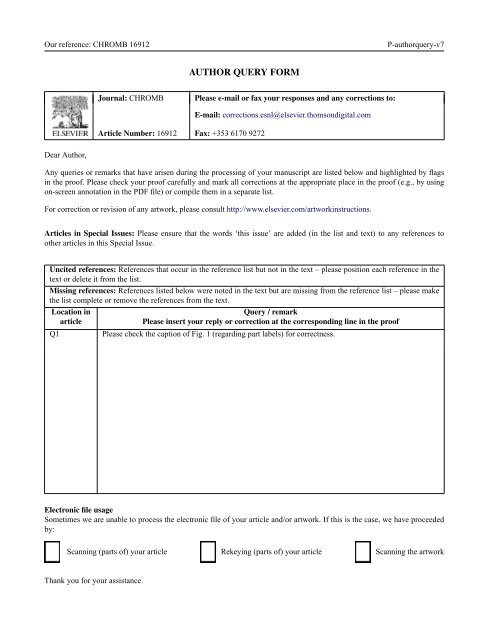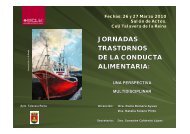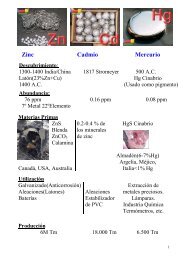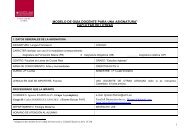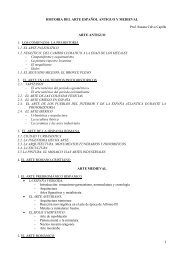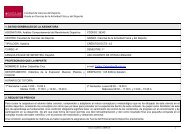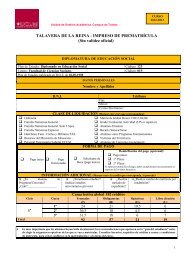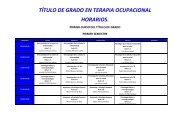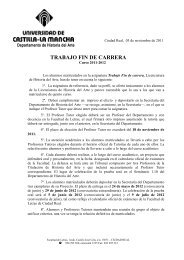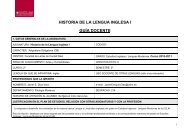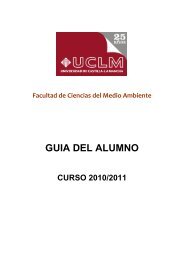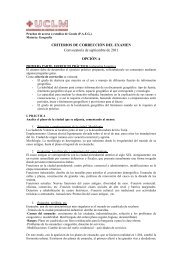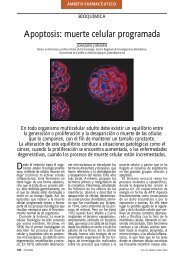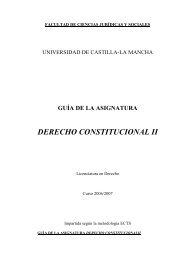Analysis by LC/ESI-MS of iophenoxic acid derivatives and ...
Analysis by LC/ESI-MS of iophenoxic acid derivatives and ...
Analysis by LC/ESI-MS of iophenoxic acid derivatives and ...
Create successful ePaper yourself
Turn your PDF publications into a flip-book with our unique Google optimized e-Paper software.
G ModelCHROMB 16912 1–6ARTICLE IN PRESS4 C. Ballesteros et al. / J. Chromatogr. B xxx (2010) xxx–xxxTable 2Reported levels (mean ± SD), recoveries <strong>and</strong> coefficient <strong>of</strong> variation <strong>of</strong> methyl-, ethyl- <strong>and</strong> propyl-IPA analyses <strong>of</strong> wild boar serum spiked with different concentrations <strong>of</strong> IPA<strong>derivatives</strong>.Spiked level (g/ml) Methyl-IPA (n = 6) Ethyl-IPA (n = 6) Propyl-IPA (n =6)Reported level(g/ml)Recovery (%) CV (%) Reported level(g/ml)Recovery (%) CV (%) Reported level(g/ml)Recovery (%) CV (%)0.02 0.01 ± 0.00 42 26 0.02 ± 0.01 98 34 0.02 ± 0.00 77 190.1 0.10 ± 0.02 98 23 0.11 ± 0.01 111 11 0.09 ± 0.02 88 180.2 0.26 ± 0.01 132 4 0.20 ± 0.01 100 3 0.17 ± 0.00 87 20.5 0.43 ± 0.03 87 8 0.46 ± 0.04 93 9 0.49 ± 0.03 98 61 0.75 ± 0.09 75 11 0.81 ± 0.08 81 10 0.87 ± 0.08 87 102 1.54 ± 0.24 77 15 1.51 ± 0.21 76 14 1.51 ± 0.18 76 124 2.98 ± 0.21 75 7 3.07 ± 0.14 77 5 3.44 ± 0.07 86 28 6.75 ± 0.10 84 1 6.74 ± 0.08 84 1 7.16 ± 0.18 89 316 17.48 ± 1.59 109 9 15.69 ± 1.27 98 8 13.68 ± 0.70 86 5Table 3Intra- <strong>and</strong> inter-day repeatability <strong>of</strong> methyl-. ethyl- <strong>and</strong> propyl-IPA analyses <strong>of</strong> wild boar serum spiked with different concentrations <strong>of</strong> IPA <strong>derivatives</strong>.Spiked level (g/ml) Methyl-IPA Ethyl-IPA Propyl-IPAIntra-day (n = 6) Inter-day (n = 6) Intra-day (n = 6) Inter-day (n = 6) Intra-day (n = 6) Inter-day (n =6)Mean SD Mean SD Mean SD Mean SD Mean SD Mean SD0.02 0.05 0.03 0.01 0.02 0.01 0.01 0.02 0.01 0.00 0.00 0.01 0.010.1 0.08 0.01 0.07 0.03 0.08 0.04 0.09 0.04 0.07 0.03 0.07 0.020.2 0.17 0.04 0.16 0.03 0.16 0.06 0.18 0.04 0.14 0.06 0.17 0.050.5 0.53 0.06 0.51 0.10 0.46 0.09 0.49 0.08 0.43 0.06 0.49 0.081 1.24 0.17 1.14 0.18 1.04 0.18 0.96 0.15 0.98 0.04 0.95 0.072 2.14 0.92 2.41 0.45 1.77 0.62 1.92 0.44 1.67 0.43 1.90 0.474 5.39 0.49 5.23 0.36 4.29 0.65 4.41 0.34 4.05 0.37 4.32 0.448 11.86 2.67 10.68 1.93 10.01 1.55 9.21 1.78 8.54 0.97 8.50 1.1316 20.52 2.35 18.79 3.01 19.04 1.87 16.68 3.22 16.36 1.35 15.12 2.35185186187188189190191192193194195196197198199200201202203204205206207208209ratio, <strong>and</strong> the limit <strong>of</strong> quantification as 10 times this ratio. This LODwas also checked to be the lowest concentration st<strong>and</strong>ard allowingunambiguous qualitative analyte detection in spiked serum. Inorder to study the recovery <strong>of</strong> the analytical procedure (accuracy)<strong>and</strong> the coefficient <strong>of</strong> variation <strong>of</strong> results (precision), calibrationcurves were made with 0.1 ml <strong>of</strong> serum <strong>of</strong> control wild boar spikedwith 2, 10, 20, 50, 100, 200, 400, 800 <strong>and</strong> 1600 ng <strong>of</strong> each IPA derivativeto obtain the same range <strong>of</strong> concentrations in the injectedextract than in a calibration curve prepared with the extract <strong>of</strong>blank wild boar serum. The use <strong>of</strong> blank serum to prepare this calibrationcurve was done to reduce the matrix effect due to ionizationsuppression. These spiked samples were processed as describedbefore for serum, although in this case the internal st<strong>and</strong>ard wasadded right before <strong>LC</strong>/<strong>MS</strong> analysis. Additionally, the analyses <strong>of</strong> sixreplicates <strong>of</strong> spikes were performed with each concentration in oneday <strong>and</strong> during different days to obtain the intra-day <strong>and</strong> interdayrepeatability values <strong>of</strong> IPA <strong>derivatives</strong> levels calculated with acalibration curve prepared with acetonitrile.2.6. Kinetic calculations <strong>of</strong> IPA <strong>derivatives</strong>For the terminal elimination half-life calculation, the values <strong>of</strong>IPAs concentration were previously log-transformed. The terminalelimination slope (k ) was obtained after a linear regressionanalysis <strong>of</strong> the terminal elimination phase between the naturallogarithms <strong>of</strong> concentration <strong>and</strong> time. The terminal half-life wascalculated following the formula t ½ = 0.693/k .3. Results <strong>and</strong> discussion 2103.1. Analytical method 211The present method differs from the procedure described <strong>by</strong> 212Jones [14] in the use <strong>of</strong> acetonitrile instead <strong>of</strong> methanol in the first 213step <strong>of</strong> the extraction. The high concentration <strong>of</strong> sodium tungstate 214in the aqueous solution, together with the cooling <strong>of</strong> the sample 215permits to separate an upper acetonitrile phase with the IPA deriva- 216tives. This has two advantages. Firstly, the extract is cleaner because 217salts <strong>and</strong> sulphuric <strong>acid</strong> are retained in the aqueous phase. Sec- 218ondly, the IPAs are more concentrated in the smaller volume <strong>of</strong> 219acetonitrile <strong>and</strong> therefore the LOD can be lower than in the largest 220mixture <strong>of</strong> the aqueous <strong>and</strong> methanolic phases analysed <strong>by</strong> Jones 221[14]. Moreover, the LOD may be improved due to the possibility 222<strong>of</strong> acetonitrile evaporation to concentrate the IPAs before <strong>LC</strong>/<strong>MS</strong> 223analysis (not used here). The chromatograms obtained with the 224method described here have a low noise <strong>and</strong> little interference 225within the retention times <strong>of</strong> IPA <strong>derivatives</strong> (Fig. 1). The use <strong>of</strong> an 226internal st<strong>and</strong>ard has been recommended before [14], but it was 227not used in the other described methods for IPAs analyses [14,15]. 228We have used Bt-IPA as internal st<strong>and</strong>ard because <strong>of</strong> its similarity 229with the other IPA <strong>derivatives</strong> in terms <strong>of</strong> extraction <strong>and</strong> analysis, 230but also because it can be perfectly separated <strong>and</strong> identified among 231the other IPAs. 232The use <strong>of</strong> <strong>MS</strong> detection in SIM mode also permitted to increase 233sensitivity <strong>and</strong> specificity <strong>of</strong> the IPA identification <strong>by</strong> monitoring 234the parent <strong>and</strong> daughter ion selected here (Fig. 2). As a conse- 235Table 4Half-life (mean ± SD) in days <strong>of</strong> the IPA <strong>derivatives</strong> in wild boar exposed to a single oral dose <strong>of</strong> bait marker.Age Dose (mg/kg b.w.) n Mt-IPA Et-IPA Pr-IPAAdult 5 3 41 ± 8 144 ± 34 108 ± 11Adult 15 3 41 ± 5 183 ± 85 165 ± 45Young 15 1 25 154 96Please cite this article in press as: C. Ballesteros, et al., J. Chromatogr. B (2010), doi:10.1016/j.jchromb.2010.05.035
G ModelCHROMB 16912 1–6ARTICLE IN PRESSC. Ballesteros et al. / J. Chromatogr. B xxx (2010) xxx–xxx 5236237238239240241242243244245246247248249250251252253254255256257258259260261262263264265266267268269270271272273274275276277278279280281282283284285286287288289290291292293294295296297298299quence <strong>of</strong> this, the LOD <strong>and</strong> LOQ in wild boar serum <strong>of</strong> this analyticalmethod were about 0.037 <strong>and</strong> 0.123 g/ml, respectively. This LODwas better than the value obtained <strong>by</strong> Jones [14] using HP<strong>LC</strong>–DADwith a larger injection volume (300 l), which was 0.05 g/mlwith a gradient analysis, <strong>and</strong> 0.2 g/ml with an isocratic analysis.Moreover, the serum volume used <strong>by</strong> us (0.1 ml) was smaller thanthe volume used <strong>by</strong> Jones [14] (0.4 ml). The method <strong>of</strong> Wiles <strong>and</strong>Campbell [15] based on <strong>LC</strong>/<strong>MS</strong>–<strong>MS</strong> yielded LOD <strong>and</strong> LOQ values<strong>of</strong> 25 ng/ml <strong>and</strong> 50 ng/ml, respectively, in the final extract <strong>of</strong> 5 mlobtained from 0.4 ml <strong>of</strong> serum. Thus, the LOD <strong>and</strong> LOQ equates to0.312 g/ml <strong>and</strong> 0.626 g/ml in serum. This LOQ was calculatedaccording to the spike levels in serum samples giving recoveryvalues (accuracy) between 80% <strong>and</strong> 120% <strong>and</strong> coefficients <strong>of</strong> variation(precision) 20%. The repeatability <strong>of</strong> the analyses<strong>of</strong> spiked samples also tended to improve at levels >0.2 g/ml, withmean accuracy within 20% <strong>of</strong> the expected concentrations <strong>and</strong> withintra- <strong>and</strong> inter-day variability 5 g/ml. This value is 302much higher than our LOQ, but as discussed <strong>by</strong> Wiles <strong>and</strong> Campbell 303[15], the quantification <strong>of</strong> the IPAs <strong>derivatives</strong> present in the serum 304<strong>of</strong> wild animals in the field may be less important because it is not 305possible to know the dose <strong>of</strong> baits ingested <strong>and</strong> the day <strong>of</strong> exposure. 306Twenty piglets which did not consume baits marked with IPAs 307were blood sampled at 4 months <strong>of</strong> age. They were born 420 days 308after IPAs administration to their mothers (female wild boar in the 309experiment). It was found that four <strong>of</strong> them (20%) showed low lev- 310els <strong>of</strong> Mt-IPA (0.001–0.009 g/ml) while all <strong>of</strong> them (100%) showed 311higher Et-IPA (0.01–1.06 g/ml) <strong>and</strong> Pr-IPA (0.02–0.72 g/ml) lev- 312els. This confirms the transplacentary passage <strong>of</strong> these compounds 313to fetal blood <strong>and</strong> the major persistence <strong>of</strong> Et- <strong>and</strong> Pr-IPA in the 314organism when compared with Mt-IPA. As observed <strong>by</strong> Miller et al. 315[18], 7 days after IPA consumption <strong>by</strong> hamster mothers total plasma 316concentrations <strong>of</strong> this compound were found equal in mother <strong>and</strong> 317fetus. Hence, IPA can cross the placental barrier to the fetal blood 318circulation. 319However, although non-consuming piglets can show IPA deriva- 320tives in their serum when their mothers had consumed them 321before, the concentration that they could show is much lower than 322the limit that we have established following a conservative crite- 323rion as a reliable value (5 g/ml) to consider that an animal had 324consumed a marked bait. 325The main objective <strong>of</strong> using markers in baits is to determine the 326proportion <strong>of</strong> a population that would be in contact with the bait 327which potentially could contain pharmaceuticals or contraceptives. 328Please cite this article in press as: C. Ballesteros, et al., J. Chromatogr. B (2010), doi:10.1016/j.jchromb.2010.05.035
G ModelCHROMB 16912 1–6ARTICLE IN PRESS6 C. Ballesteros et al. / J. Chromatogr. B xxx (2010) xxx–xxx329330331332333334335336337338339340341342343344345346347348349350351The marked baits could be delivered at field; hence, it would benecessary to test the safety <strong>and</strong> toxicology <strong>of</strong> the marker. The safety<strong>of</strong> IPA was studied in mice, rats, guinea pigs, <strong>and</strong> dogs [19]. No signs<strong>of</strong> pathological changes in organs <strong>of</strong> treated animals with IPA werefound. It was obtained a LD 50 <strong>of</strong> 1850 mg/kg when IPA was deliveredto mice <strong>by</strong> the oral route [19]. None <strong>of</strong> the nine wild boar whichwere administrated IPA showed any sign <strong>of</strong> disease, all <strong>of</strong> themwere in healthy conditions 2 years after IPA consumption. No signs<strong>of</strong> disease were observed in piglets born from females consumingIPAs some months before their birth.In conclusion, IPA <strong>derivatives</strong> studied here could be used asmarkers for baiting campaigns to deliver vaccines, medicines<strong>and</strong>/or contraceptives to wildlife due to their efficacy to “mark”the serum <strong>of</strong> animals for 9 months after the consumption <strong>of</strong> Mt-IPA,<strong>and</strong> up to 18 months after the consumption <strong>of</strong> Et- <strong>and</strong> Pr-IPA. Thesemarkers present the advantage <strong>of</strong> being easily detectable in a bloodsample, in comparison with other markers such as tetracycline orrhodamine B detected in bone <strong>and</strong> teeth [2,3].AcknowledgementsWe thank Alfredo Peña <strong>and</strong> colleagues from IREC for their technicalassistance at animal management. This study was supported<strong>by</strong> grants from Instituto Nacional de Investigación y TecnologíaAgraria y Alimentaria (INIA) (Project FAU 2006-00017-C03-01),Consejería de Educación y Ciencia, Junta de Comunidades deCastilla-La Mancha (JCCM) (project PAI 06-0046-5285), the Grupo 352Sant<strong>and</strong>er <strong>and</strong> the Fundación Marcelino Botín, Spain. Animal exper- 353iments were performed in accordance with Spanish <strong>and</strong> European 354legislation. 355References 356[1] D.A. Cowan, J.A. Vaughan, K.J. Prout, W.G. Christer, J. Wildl. Manage. 48 (1984) 3571403. 358[2] L.G. Schneider, J.H. Cox, W.W. Muller, K.P. Hohnsbeen, Rev. Infect. Dis. 10 (1988) 359654. 360[3] D.H. Johnston, D.R. Voigt, C.D. MacInnes, P. Bachmann, K.F. Lawson, C.E. Rup- 361precht, Rev. Infect. Dis. 10 (1988) 660. 362[4] S.B. Linhart, J.J. Kennelly, J. Wildl. Manage. 31 (1967) 317. 363[5] J.K. Crier, J. Wildl. Manage. 34 (1970) 829. 364[6] G. Saunders, S. Harris, C.T. Eason, Wildl. Res. 20 (1993) 297. 365[7] M.D. Shapiro, Radiology 60 (1953) 68. 366[8] E.B. Astwood, Trans. Assoc. Am. Phys. Phila. 7 (1957) 183. 367[9] W.O. Fletcher, T.E. Creekmore, M.S. Smith, V.F. Nettles, J. Wildl. Dis. 26 (1990) 368502. 369[10] J. Mitchell, Wildl. Res. 25 (1998) 297. 370[11] P.J.S. Fleming, D. Choquenot, R.J. Mason, Wildl. Res. 27 (2000) 531. 371[12] T.A. Campbell, S.J. Lapidge, D.B. Long, Wildl. Soc. B 34 (2006) 1184. 372[13] G. Massei, A. Jones, T. Platt, D.P. Cowan, J. Wildl. Manage. 73 (2009) 458. 373[14] A. Jones, J. Chromatogr. B 654 (1994) 293. 374[15] M.C. Wiles, T.A. Campbell, J. Chromatogr. B 832 (2006) 144. 375[16] V. Kaden, E. Lange, U. Fischer, G. Strebelow, Vet. Microbiol. 73 (2000) 239. 376[17] C. Ballesteros, J.M. Garrido, J. Vicente, B. Romero, R.C. Galindo, E. Minguijón, et 377al., Vaccine 27 (2009) 6662. 378[18] R.K. Miller, V.H. Ferm, G.H. Mudge, Am. J. Obstet. Gynecol. 114 (1972) 259. 379[19] S. Margolin, I.R. Stephens, M.T. Spoerlein, A. Makovsky, G.B. Bell<strong>of</strong>f, J. Am. 380Pharm. Assoc. 42 (1953) 476. 381Please cite this article in press as: C. Ballesteros, et al., J. Chromatogr. B (2010), doi:10.1016/j.jchromb.2010.05.035


